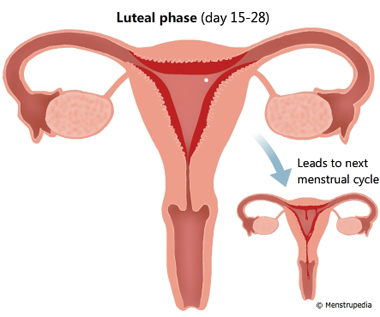MENSTRUAL CYCLE
The reproductive period of the human female continues from about the age of 13 years to 45-50 years.
In females, ovaries release ovum or egg once every 28 days from the age of puberty. The uterus prepares itself every month to receive a fertilized egg.
Thus, its lining becomes thick and spongy. If the egg is not fertilized it lives for about a day. Afterwards this lining of the uterus is no longer required and Menstruation Occurs.
This period is marked by a characteristic event repeated almost every month (28 days with minor variation) in the form of a menstrual flow.
Also Check – Why does Menstruation occur ?
It may be temporarily stopped only by pregnancy.
The period of a menstrual cycle is counted from the day of the onset of the flow to the next onset after 28 days .
Menstural Cycle has 4 phases

- Menstrual phase
- Follicular phase
- Ovulatory phase
- Luteal phase
Menstrual phase :

- It lasts for 3-5 days during which blood is discharged.
- The bleeding is caused due to the shedding and rupturing of the blood vessels that make up the thickened innermost lining of the uterus, called the endometrium.
- Starting from the onset of the menstruation flow, the ovary begins to form a new egg in a follicle.
Also Check – Reproduction In Human Beings
Follicular phase :

- It continues from days 5-12.
- As the follicle grows, the amount of oestrogens produced by the ovary increases.
- This hormone then acts on the uterus and causes its lining to become thicker and develop more blood vessels.
- This change is a kind of preparation of the uterus to receive the fertilized egg and assist in the early implantation of the embryo and its subsequent development.
Ovulatory phase :

- On about the 13th or 14th day, the follicle ruptures (ovulation) and the released egg travels down the oviduct.
- The two hormones produced by the pituitary gland, follicle stimulating hormone (FSH) and
- luteinizing hormone (LH), promotes the maturation and release of the ovum.
Luteal phase :

- It lasts from days 15-28.
- Uterus lining thickens further and after the release ofthe ovum, the emptied follicle in the ovary turns into a hormone-producing tissue called corpus luteum .
- If the ovum is fertilized, the corpus luteum continues to release progesterone and so keeps the uterus in a state suitable for implantation.
- However, if on the other hand there is no fertilization, the ovum disintegrates and the corpus luteum stops producing progesterone.
- As a result, the thickened lining of the uterus (endometrium) restarts shedding on the 28th day and loses blood which escapes through the cervix and vagina.

